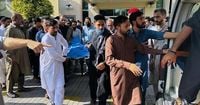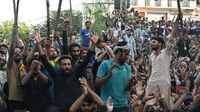In the hilly valleys and bustling towns of Pakistan-administered Kashmir, a wave of unrest has swept through the region since September 29, 2025, culminating in some of the most violent protests seen in years. What began as a demand for basic subsidies on food and electricity has exploded into a broader movement against government policies, elite privileges, and, increasingly, the heavy-handed response of security forces. As the dust settles—if only momentarily—at least 12 civilians and three police officers have lost their lives, with hundreds more injured and entire communities cut off from the outside world.
According to the Associated Press, the violence erupted when thousands of demonstrators, organized under the banner of the Awami Joint Action Committee (AJAC), clashed with police across multiple towns in Pakistan-administered Kashmir. The protesters, some armed with sticks and even guns, attacked officers who were deployed to prevent road blockages and property damage. Police officer Mohammad Afzal confirmed that three police officers and a civilian died in the initial clashes, and at least eight officers were left in critical condition after being struck on the head with stones and sticks.
But the toll didn’t stop there. As reported by the region’s Press Information Department (PID), the death count rose to at least six protesters and three policemen, with about 172 police officers injured—12 of them seriously—and 50 civilians hurt in the violence. Meanwhile, leaders from the Jammu Kashmir Joint Awami Action Committee (JKJAAC) claim the real number is even higher, alleging that 12 of their supporters have been killed and more than 200 injured, most with gunshot wounds. "All have suffered gunshot wounds," stated JKJAAC member Syed Hafeez Hamdani in a written message, pushing back against official claims that most demands have been met.
What’s driving this surge of anger? The roots of the protests stretch back two years, when similar demonstrations forced the government to promise regular and subsidized supplies of flour and electricity—basic necessities for many in the region. That agreement, however, remains only partially fulfilled, according to activists and community leaders. Over time, the movement has grown, with protesters now presenting a 38-point charter of demands. These include abolishing 12 reserved assembly seats for Kashmiri refugees, rolling back elite privileges, securing free education and healthcare, completing stalled development projects, providing tax relief, and reforming the judiciary.
Large rallies have been staged in Muzaffarabad, Kotli, and Mirpur, with the Joint Awami Action Committee at the forefront. The movement’s unity and determination were on full display at Muzaffarabad’s Lal Chowk, where leaders such as Shaukat Nawaz Mir addressed the crowds, reinforcing calls for government action. Slogans like “Rulers, beware, we are your doom” and “Kashmir is ours, we will decide its fate” echoed through the streets, marking a rare and direct challenge to both the Pakistani government and military. As India Today reported, this is perhaps the first time in decades that citizens of Pakistan-administered Kashmir have so openly targeted Islamabad and the army.
Security forces responded with a show of force. Videos circulated on social media show Pakistani Rangers and police firing tear gas shells, moving in to take control of the streets, and in some cases, allegedly opening fire on peaceful protesters. The government imposed a near-total communication blackout, shutting down mobile, internet, and landline services, which left families isolated and heightened anxiety across the region. Protesters attempting to march toward Muzaffarabad found roads sealed and bridges blocked by shipping containers.
In Dudyal, Mirpur, the Action Committee refused to bury a protester’s body until authorities agreed to their demands, highlighting the depth of frustration and the lengths to which communities are willing to go. According to ANI, security forces cleared bridges to block protest marches, but large rallies persisted despite the clampdown. The violence has spilled over into Rawalakot, Neelum Valley, and other towns, with markets, shops, and local businesses shuttered since the protests began.
The government’s response has been a mix of concessions and warnings. Chaudhry Anwarul Haq, Prime Minister of Pakistan-held Kashmir, told reporters in Islamabad that his administration had met 90% of the protesters’ demands, including reduced electricity tariffs, local government reforms, and the withdrawal of cases against demonstrators. However, he noted that two key demands—reducing the number of ministers and scrapping reserved seats for refugees—require legislative action. Cabinet members were stationed in Muzaffarabad and Rawalakot, ready to negotiate, but Haq warned that continued agitation would only plunge the region into chaos. "This paradise-like valley must not be turned into a battlefield," he pleaded, echoing a sentiment shared by many on all sides of the conflict.
Pakistan’s Prime Minister Shehbaz Sharif, speaking from abroad, expressed deep concern over the situation. According to his office, he urged law enforcement agencies to exercise restraint and tolerance, stating, "Public sentiments should be respected and any unnecessary harshness should be avoided." Sharif also ordered a transparent investigation into the incidents and reaffirmed his government’s willingness to resolve the problems faced by Kashmiris. In a further bid to defuse tensions, Sharif formed a negotiation committee to address the issues and called for a peaceful resolution.
Yet, protest leaders remain skeptical. The JKJAAC’s Hamdani rejected the government’s claims, stating, "The claim that our demands have been accepted is contrary to the facts… If our demands had been accepted, we would have had no reason to keep protesting." Community frustration is compounded by memories of previous broken promises. In May 2024, a similar wave of protests left at least four dead and resulted in a government grant of Rs 23 billion ($86 million) for subsidies, as well as a judicial commission to review elite privileges. Protest leaders suspended their campaign then, but warned that failure to implement the package would ignite new unrest—a warning that has now come to pass.
Meanwhile, accusations of militarization and human rights abuses are mounting. Mahmood Kashmiri, Chairman of the Jammu and Kashmir National Alliance, accused Pakistani authorities of militarizing the region by stationing troops at key entry points and distributing weapons to civilians, actions he says are fueling tensions and threatening peaceful resistance. He issued a stern ultimatum to Islamabad, calling for the withdrawal of troops and an immediate end to "plans to kill" peaceful citizens. International voices have also weighed in; Nasir Aziz Khan, spokesperson for the United Kashmir People's National Party, appealed to the United Nations and the global community for urgent intervention, warning of a looming humanitarian crisis.
For now, the region remains tense, with families grieving, businesses shuttered, and trust in government at a low ebb. Whether dialogue can bring calm—or whether further unrest lies ahead—remains uncertain. But what is clear is that the people of Pakistan-administered Kashmir have found their voice, and they are determined to be heard.


